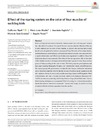Please use this identifier to cite or link to this item:
https://accedacris.ulpgc.es/handle/10553/69883
| Title: | Effect of the rearing system on the color of four muscles of suckling kids | Authors: | Ripoll, Guillermo Alcalde, María Jesús Argüello Henríquez, Anastasio Córdoba, María de Guía Panea, Begoña |
UNESCO Clasification: | 3104 Producción Animal | Keywords: | Biceps Femoris Chop Milk Replacer Semimembranosus Semitendinosus |
Issue Date: | 2019 | Journal: | Food Science and Nutrition | Abstract: | Most suckling kids are raised on farms for cheese production, and many goat farmers rear kids with milk replacers. The aim of this work was to study the influence of the use of milk replacers on the color of four muscles. A total of 246 suckling kids of eight breeds were slaughtered to achieve carcasses of 5 kg. The color of the biceps femoris, semimembranosus, semitendinosus, and longissimus thoracis muscles was measured with a spectrophotometer, and CIELab coordinates were registered. In addition, the pH of longissimus thoracis was measured. The effect of the rearing system (RS) on the color of the studied muscles is strongly modulated by breed. In general terms, there are two groups of kids according to the color of meat. The first group has great lightness and hue angle including Malagueña, Palmera, and Tinerfeña fed natural and artificial milk. The second group with great redness includes Retinta, Payoya, and Verata fed natural and artificial milk together with Florida fed natural milk and Cabra del Guadarrama fed milk replacers. Hence, farms should consider selecting a breed and RS together. Most of the kid meat with high pH comes from kids raised on milk replacers. Because artificial RSs use very early weaning, which might induce a high pH and dark meat, two artificial rearing strategies can be proposed. The first strategy is to choose less sensitive breeds that produce meat with a normal pH. The second strategy is to restrict suckling of natural milk but minimize separation from the mother. | URI: | https://accedacris.ulpgc.es/handle/10553/69883 | ISSN: | 2048-7177 | DOI: | 10.1002/fsn3.994 | Source: | Food Science & Nutrition [ISSN 2048-7177],v. 7 (4), p. 1502-1511, (Abril 2019) |
| Appears in Collections: | Artículos |
SCOPUSTM
Citations
9
checked on Jun 8, 2025
WEB OF SCIENCETM
Citations
9
checked on Jun 8, 2025
Page view(s)
123
checked on May 17, 2025
Download(s)
98
checked on May 17, 2025
Google ScholarTM
Check
Altmetric
Share
Export metadata
Items in accedaCRIS are protected by copyright, with all rights reserved, unless otherwise indicated.
